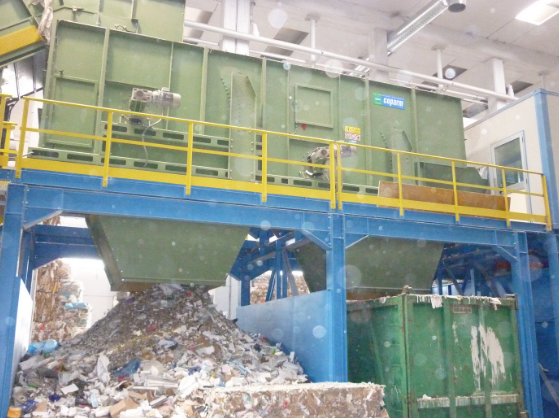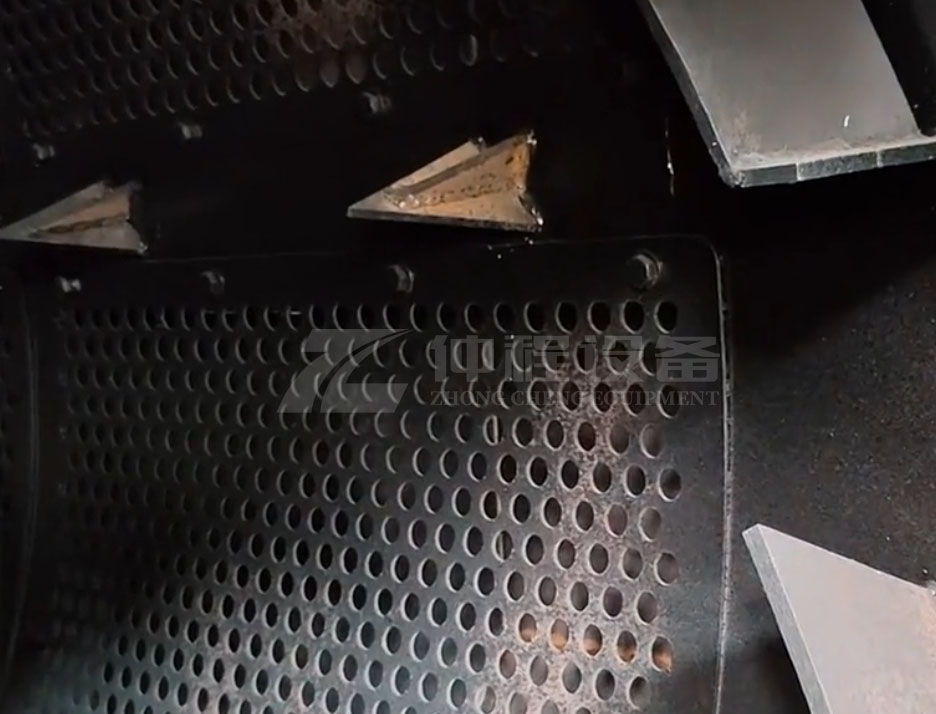Rotary Drum Screen in Waste Treatment
As the global population continues to grow, so does the amount of waste generated. With environmental regulations tightening and an increasing emphasis on recycling, effective waste treatment and sorting systems have become critical. One of the key machines in waste treatment plants is the rotary drum screen, also known as a trommel screen. This waste sorting machine plays a pivotal role in separating materials by size, ensuring that waste is efficiently processed and either recycled or disposed of properly. This article explores the rotary drum screen’s design, operation, and benefits in modern waste treatment facilities.

Understanding the Rotary Drum Screen
A rotary drum screen is a mechanical screening machine used to separate materials based on size, commonly found in municipal solid waste (MSW) and industrial waste treatment plants. The drum is a cylindrical structure perforated with holes or mesh of varying sizes. As the drum rotates, waste material is fed into it, and particles smaller than the holes fall through, while larger materials continue to pass through the drum until they exit at the opposite end.
The rotary drum screen is crucial for pre-sorting and preparing waste for further treatment. It can separate materials such as:
- Plastic
- Paper
- Organic matter
- Metals
- Glass
These materials are then directed toward their respective processing streams, such as recycling or energy recovery.
Design and Functionality
The drum screen consists of a large rotating cylindrical drum mounted at a slight incline. Waste material is fed into one end of the drum, and as it rotates, the material moves down the drum's length due to gravity. The drum is perforated with holes or mesh, and smaller particles fall through the holes into collection areas or conveyor belts, while larger particles travel the length of the drum and exit at the other end.
The angle of the drum, its rotational speed, and the size of the screen holes can be adjusted to accommodate different waste streams and sorting requirements. For instance, larger holes may be used for coarse sorting, such as separating bulky materials like plastic or cardboard, while smaller holes allow for finer sorting of organic waste, soil, or dust.
Key Components of a rotary drum screen include:
- Feed Hopper: Where waste material is loaded into the machine.
- Rotary Drum: The cylindrical screen that rotates to separate materials.
- Drive System: Responsible for rotating the drum at the desired speed.
Discharge Area: Where sorted materials exit the machine.
![E]LZ13{GI[JS1FI0DTN_8S6.png](/uploads/allimg/20240910/1-24091009492N92.png)
Applications of Rotary Drum Screens
Rotary drum screens are versatile and can be used in a variety of waste treatment processes. They are particularly effective in:
Municipal Solid Waste (MSW) Treatment: In MSW facilities, rotary drum screens are commonly used to sort mixed waste. The separation of organic waste from recyclable materials like paper, plastic, and metals is critical to improve recycling rates and reduce landfill usage.
Industrial Waste Treatment: Industries generate significant amounts of solid waste, which may include metals, plastics, and other materials. Rotary drum screens help in the initial sorting process by removing smaller, unwanted materials, allowing more valuable or hazardous materials to be isolated and treated appropriately.
Composting Operations: Organic waste can be separated from other materials, ensuring that only compostable materials enter the composting process. Rotary drum screens are highly efficient at screening organic material, leading to improved compost quality.
Recycling Plants: In recycling facilities, rotary drum screens can separate recyclables based on size, improving the efficiency of sorting machines downstream. They also reduce the contamination of recyclable streams, increasing the overall quality of the processed materials.
Mining and Aggregate Operations: Rotary drum screens are used in mining operations to sort materials like gravel, sand, and minerals. Though not directly related to waste management, the principle remains the same: efficient separation based on size.

Benefits of Rotary Drum Screens in Waste Treatment
1. High Sorting Efficiency: Rotary drum screens excel at sorting materials based on size, ensuring that waste is properly separated for further processing. This leads to a more efficient overall waste treatment process, with recyclable materials being properly identified and sent to the correct streams.
2. Customizable for Different Waste Types: Rotary drum screens can be tailored to specific waste streams, making them versatile machines. By adjusting the size of the screen holes, drum angle, and rotation speed, the system can handle a wide range of waste types, from household trash to industrial debris.
3. Cost-Effective Solution: The simplicity of the rotary drum screen’s design ensures that it is a cost-effective solution for waste sorting. It requires minimal maintenance and has a long operational life, reducing the need for costly repairs or frequent replacements.
4. Reduces Labor Costs: With the automation of the sorting process, rotary drum screens significantly reduce the need for manual labor in waste sorting. This not only cuts costs but also improves safety by reducing workers' exposure to potentially hazardous materials.
5. Enhances Recycling Rates: By effectively separating recyclable materials from waste, rotary drum screens increase recycling rates and reduce the volume of waste sent to landfills. This not only conserves natural resources but also minimizes environmental impacts associated with landfill disposal.

Challenges and Considerations
Despite their many benefits, rotary drum screens are not without challenges. Clogging can occur when wet or sticky waste materials, such as organic matter, block the screen holes. Regular cleaning and maintenance are necessary to ensure continuous operation. Additionally, while rotary drum screens are effective for size-based sorting, they may not be ideal for separating materials that have similar sizes but different properties, such as separating plastics from paper.
Another consideration is the energy consumption of the machine. Rotary drum screens require power to rotate the drum, and the energy costs may vary depending on the scale of the operation.
Conclusion
The rotary drum screen plays an essential role in modern waste treatment and sorting facilities. Its ability to efficiently separate materials based on size makes it a key component in improving recycling rates and reducing the environmental impact of waste disposal. With customizable features and a relatively low operational cost, the rotary drum screen is a versatile and effective solution for various waste treatment applications. As waste treatment technologies continue to evolve, machines like the rotary drum screen will remain central to achieving a cleaner and more sustainable future.
-
 Trommel screenTrommel screen, also known as drum screens, are widely used in various industries for sorting and separating materials.Get Quote
Trommel screenTrommel screen, also known as drum screens, are widely used in various industries for sorting and separating materials.Get Quote -
 Crop straw double shaft shreddApplications:Biomass Energy Production: Shredded straw can be used as a feedstock for bioenergy plants to produce electricity or heat.Livestock Feed: Reduced-si...Get Quote
Crop straw double shaft shreddApplications:Biomass Energy Production: Shredded straw can be used as a feedstock for bioenergy plants to produce electricity or heat.Livestock Feed: Reduced-si...Get Quote -
 Zhongcheng Air Drum SeparatorAir drum separators effectively separate lightweight materials (e.g., plastics, paper) from heavier materials (e.g., metals, glass). This high efficiency is cru...Get Quote
Zhongcheng Air Drum SeparatorAir drum separators effectively separate lightweight materials (e.g., plastics, paper) from heavier materials (e.g., metals, glass). This high efficiency is cru...Get Quote
-
2024-06-07Zhongcheng Air Drum Separator in MSWAir drum separators effectively separate lightweight materials (e.g., plastics, paper) from heavier materials (e.g., metals, glass). This high efficiency is cru...
-
2023-01-13Bag OpenerBag opener or bag opener system is a mechanical device used to automatically open and empty bags containing bulk materials. This system is commonly used in indu...
-
2025-03-03Mini Copper Wire GranulatorThe copper wire granulator machine is a device specially used to process waste wires and cables. Its main function is to separate the copper and plastic in the ...
-
2024-08-12Wood Pallet ShredderConsiderations When Choosing a Wood Pallet Shredder:Material Type: Different wood types may require specific configurations or materials of construction.Output ...
-
2025-04-21Compact Copper Cable Granulator MachineThe compact copper cable granulator machine is a device used to recycle waste wires and cables. It separates the copper wire from the plastic sheath by crushing...



